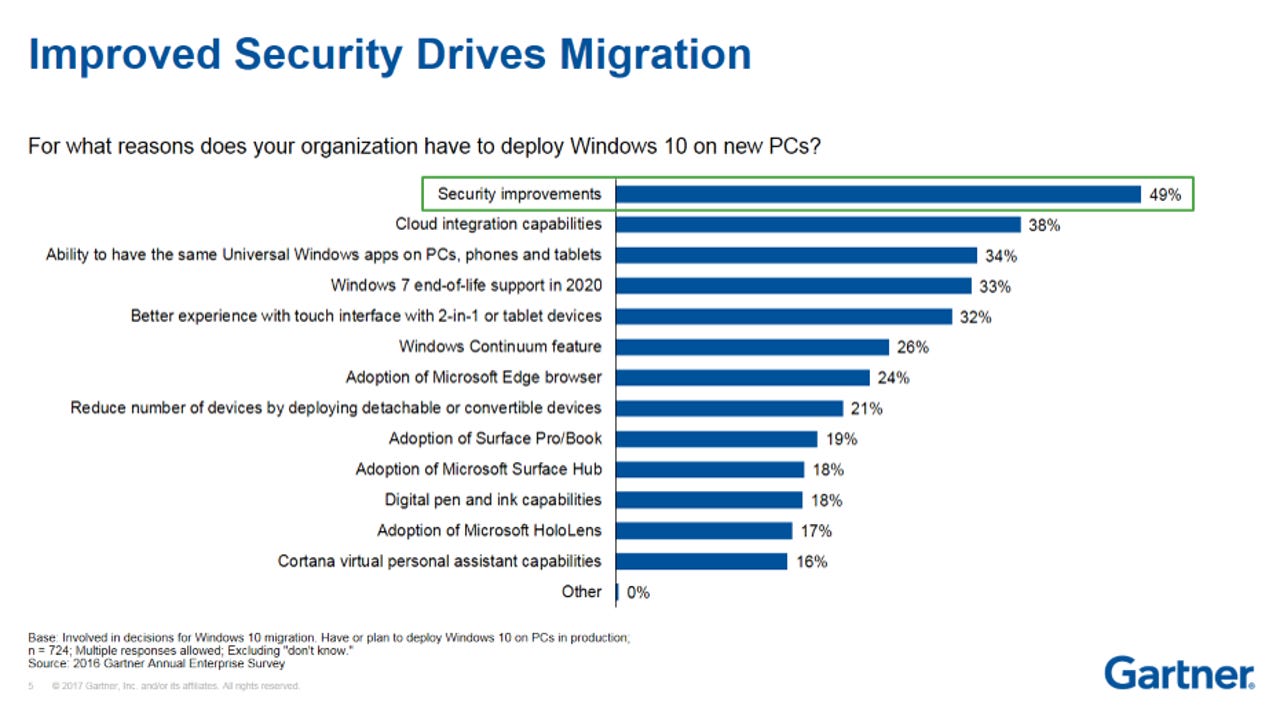Why Windows 10 rollout is happening faster than shift from XP to Windows 7


Better security, cloud integration, and universal apps are the top reasons why organizations are migrating to Windows 10.
Microsoft's security-focused campaign to convince enterprises to upgrade to Windows 10 appears to be paying off. Research suggests firms are deploying Windows 10 faster than they shifted from XP to Windows 7.
The survey by analyst firm Gartner has found that 85 percent of organizations will have started a Windows 10 production deployment by the year's end, and the most common reason they're citing for doing so is to boost security.
Microsoft in January reminded customers that it would stop patching Windows 7 on January 13, 2020. But even with patches, it warned that Windows 7 already wasn't fit to meet "the high security requirements of IT departments".
Asked why they are moving to Windows 10, 49 percent of respondents cite "security improvements", followed by 38 percent who are migrating for cloud-integration capabilities.
Other common reasons for moving include Windows 7 end-of-life support in 2020, running Universal Windows apps on PCs and mobile devices, and a better touch experience on 2-in-1 devices, such as Microsoft's Surface Pro, or tablets. Around a third of respondents nominated these factors as motivating the migration.
"Organizations recognize the need to move to Windows 10, and the total time to both evaluate and deploy Windows 10 has shortened from 23 months to 21 months between surveys that Gartner did during 2015 and 2016," said Ranjit Atwal, research director at Gartner.
"Large businesses are either already engaged in Windows 10 upgrades or have delayed upgrading until 2018. This likely reflects the transition of legacy applications to Windows 10 or replacing those legacy applications before Windows 10 migration takes place."
Gartner conducted the survey of 1,014 respondents from the US, UK, France, China, India, and Brazil between September and December 2016.
It found that 46 percent of respondents expected to start deploying Windows 10 in production by the end of 2016, while 23 percent would begin in the first half of 2017, and 16 percent would start in the second half. A further nine percent expected to start in 2018, while four percent will start in 2019 or later.
Following its 2015 Windows 10 enterprise survey, Gartner estimated that about 50 percent would have commenced a migration. The main reasons were end of support for Windows 7, strong compatibility with Windows 7 applications and devices, and a pent-up demand for tablet and 2-in-1 device rollouts.
The analyst firm also found that organizations are keener to buy new devices as hardware is becoming optimized for Windows features.
Gartner principal research analyst Meike Escherich said respondents' device-buying intentions had significantly increased as organizations saw third- and fourth-generation products optimized for Windows 10, with longer battery life, touchscreens, and other Windows 10 features.
"The intention to purchase convertible notebooks increased as organizations shifted from the testing and pilot phases into the buying and deployment phases," he said.